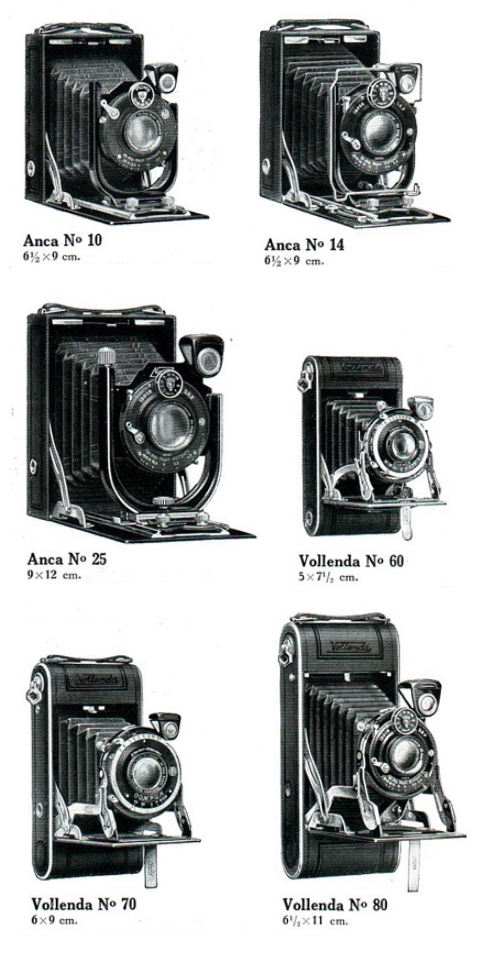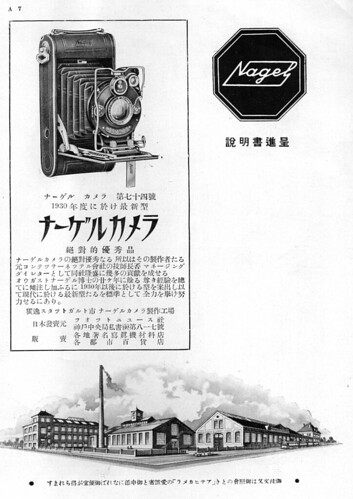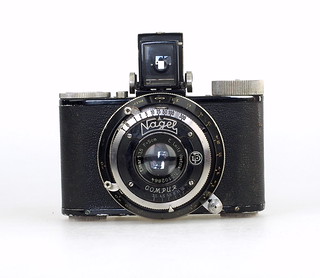Nagel
| |||||
| Photo industry in Stuttgart | |||||
| Contessa | Contessa-Nettel | Drexler & Nagel | Ebner | Hauff | Kenngott | Kodak AG | G. A. Krauss | Nagel | Zeiss Ikon | |||||
Nagel was a short lived German camera brand, based in Stuttgart, which was used for a series of high quality cameras between 1928 and 1931. Its founder, Dr. August Nagel, started this business under his own name after he left his former enterprise Contessa-Nettel, which was forced into the merger of different German camera makers, which became Zeiss Ikon. After only four years as an independent and despite difficult times successful player on the market he sold his company to Eastman Kodak. However, the venture kept running under its new name Kodak AG - Dr. Nagel Werk and August Nagel was appointed General Manager. It was a win-win situation for both: Kodak was enjoying the reputation of having their brand on quite a series of very innovative designs made in Germany, and August Nagel could focus on his main talent: designing and producing cameras, while Kodak gave him the necessary financial support for strong growth and a global distribution network.
In 1928 Nagel started with a series of high quality folding plate and roll film cameras and became famous for its small format camera Pupille. After 1932 many of the cameras were kept in the portfolio but now carried the Kodak brand. In the mid-1930s, Dr. Nagel devised a 35mm film cassette that would fit the successful Leica and Contax rangefinder cameras; Nagel also shrank its earlier Vollenda camera to fit this smaller format—creating the Retina). Kodak in the US promoted this new film packaging as 135 format, and it soon became the 35mm standard that is universal today.
Cameras

|
| Nagel cameras from a 1930 catalog (Image rights) |
Rigid
Folding
- Triumph
- Librette No. 65/No. 74 (6x9 on 120 film, No. depends on lens and/or shutter combination; 1928-1931; about 4000 units)
- Librette No. 75 (6x9 on 120 film, with Schneider lenses and Compur shutter; 1933)
- Librette No.79 (6.5x11 on 116 film, 1930-1931, ca. 1000 units
- Vollenda series of folding cameras for different roll films and formats:
| Vollenda No. | 48 | 52 | 60 | 68, 70, 72 | 80 |
|---|---|---|---|---|---|
| Image size (ca.) | 3 x 4 cm | 4 x 6.5 cm | 5 x 7.5 cm | 6 x 9 cm | 6.5 x 11 cm |
| Film type | 127 | 129 | 120 | 116 | |
| Focal length | 5 cm | 7.5 cm | 9 cm | 10.5 cm | 12 cm |
| Year(s) | 1931-37 | 1932-37 | 1930-31 | 1930-34 | 1930-1931 |
| Units | ca. 43,000 | ca. 6,000 | ca. 1,000 | ca. 15,000 | ca. 1,000 |
The series was introduced with the models 60, 70, and 80 in ealry 1930. All models were available with a selection of different lenses (Nagel, Schneider or Leitz) and shutters (Nagel, Pronto-S, Compur). Some of them continued in production after Kodak took over the company in 1932 as "Kodak Vollenda" with the same model numbers. In 1934 the larger roll film types were consolidated into the newly introduced...
Film plates
From 1928-1930 the cameras only carried their respective Nagel No., starting from 1930 the respective Name (Anca, Recomar, Fornidar) was added. All models were available with a selection of different lenses (Nagel, Schneider or sometimes Leitz) and shutters (Nagel, Ibsor, Pronto, Pronto-S, Compur, Compur-S).
- Anca No.10/No.14 (6.5x9 cm plates, 1928-1934, ca. 2,600 units)
- Anca No.25 (9x12 on plate, 1928-1934, ca. 1,600 units)
- Recomar No. 18 (6.5x9 cm on plate, 1928-1939, 20,250 units)
- Recomar No. 33 (9x12 cm on plate, 1928-1939, ca. 20,000 units)
- Fornidar No. 30 (9x12 cm on plate, 1930-1931, ca. 1,000 units)
|
| ||||
| two famous Nagel designs for 3x4 images on 127 film | |||||
History

|
| Advertisement in Asahi Camera February 1930, showing the Nagel No.714. (Image rights) |
August Nagel was born on June 5th, 1882 as the oldest of 9 siblings in Pfrondorf/Tübingen, Germany. Already at young age he started constructing cameras. In 1908, together with his friend Carl Drexler, he founded his first company Drexler & Nagel in Stuttgart. Already in 1909, after some quick market success, this would become Contessa-Camerawerke GmbH. Within a few years the company grew to a few hundred employees, during WW1 Nagel contributed with some aerial constructions. In 1918 he was rewarded with a honorary PhD degree from the University of Freiburg. After the war the company acquired the Nettel-Kamerawerk and was renamed Contessa-Nettel.
With this merger the company further expanded and opened further production locations in the area. This expansion was financed by taking more and more shareholders on board, and suddenly August Nagel found himself with less than a controlling interest in the company. The Carl Zeiss Stiftung (Foundation) hold some depts (lens deliveries) and during the economical and financial crisis in 1923 other shareholders sold their shares to the Stiftung, which became the controlling entity. The Stiftung combined their existing shares into several camera producers and Zeiss Ikon was founded. At first Nagel served the company as one of their board members, but eventually he left Zeiss Ikon on March 31st, 1928. By selling his remaining shares he bought the former Schwäbisches Presswerk, renovated the industrial site in Stuttgart-Wangen and hired (many of his former) employees.
Inauguration of the new Nagel-Werke already took place on April 5th, 1928 and camera sales started in November. With affordable but high quality cameras he succeeded on the market even during difficult economical times. Production grew constantly by double digit growth rates, further expansion was necessary.
In this situation at the age of 49, he got an offer from Eastman Kodak, he could not decline. George Easman was looking to expand Kodak's German operations from a simple distributor (since 1896 in Berlin), through local film making (acquisition of Glanzfilm AG in Berlin, 1927) to a local camera production. German cameras at this time were regarded top-notch and he would rather acquire an existing company with high quality reputation than establish an own production with American or UK models. The offer to August Nagel included to stay as General Manager of the company and continue to develop and produce affordable high quality cameras.
The contract between Kodak and Nagel was signed in December 1931, and from early 1932 on (times of the biggest depression in Germany) August Nagel was proud that he was able to continue his expansion, while others had to let go employees. The first camera launch with the new Kodak logo was the Vollenda 52, a small folder for 4x6.5 cm images on 127 film. Some existing designs were continued and some new cameras were launched (e.g. the Kodak Vollenda 620 and Duo 620). The biggest invention, though, August Nagel contributed to Kodak's global success was the Retina together with the universal 135 film cartridge.
Within the 1930ies production grew constantly and almost 2 million cameras were produced in Stuttgart during this time. In 1941 the camera production stopped and the site produced other things for the war. August Nagel died on October 30, 1943 at age 61. He was spared experiencing the destruction of his work on the night of March 2nd to 3rd, 1944. However, camera production already resumed in 1945 and the following decades until the late 1960ies were even more successful for Kodak AG in Stuttgart. Actually, August Nagel's son Helmut (born 1914) became CEO of this company in 1953.
Links
- NAGEL, Helmut: Zauber der Kamera: Beispiele aus dem Kodak-Nagel-Werk, Deutsche Verlags-Anstalt, 1977. ISBN 3421025169.
- Further Thoughts on August Nagel, by Larry Gubas, at Zeiss Historica, vol. 29, Fall 2007, pages 21-22.
- August Nagel and the Retina, by Peter Wallage, at Zeiss Historica, vol. 27, Fall 2005, pages 10-15.
- Zeiss Ikon and Dr. August Nagel (History), by Larry Gubas, at Zeiss Historica, vol. 6, Spring 1984, page 4.
- August Nagel-Werke at Brian Wallen's Cameras of Kodak's Golden Age
- Historical Society for Retina Cameras (archived)
- Retina Rescue - Chris's Camera Pages, by Chris Sherlock
- Original Retina by Sylvain Halgand (in French)
- Nagel page at Collection G. Even's site (in French)


